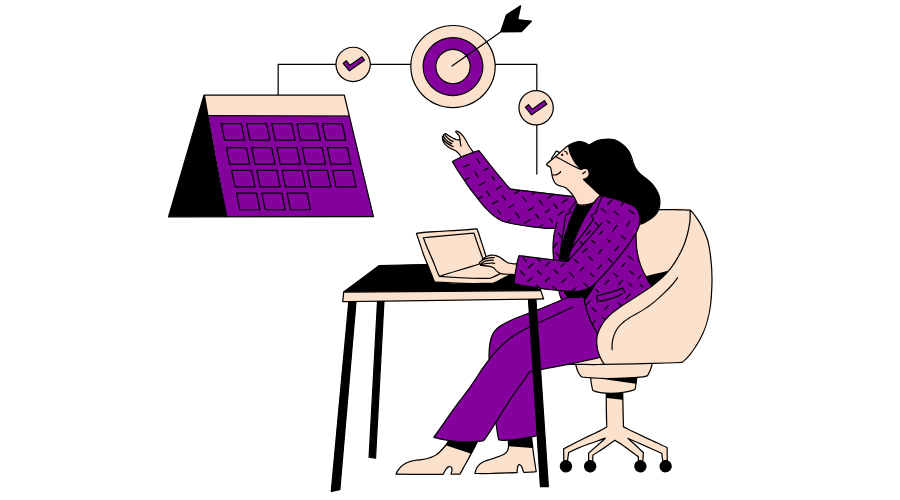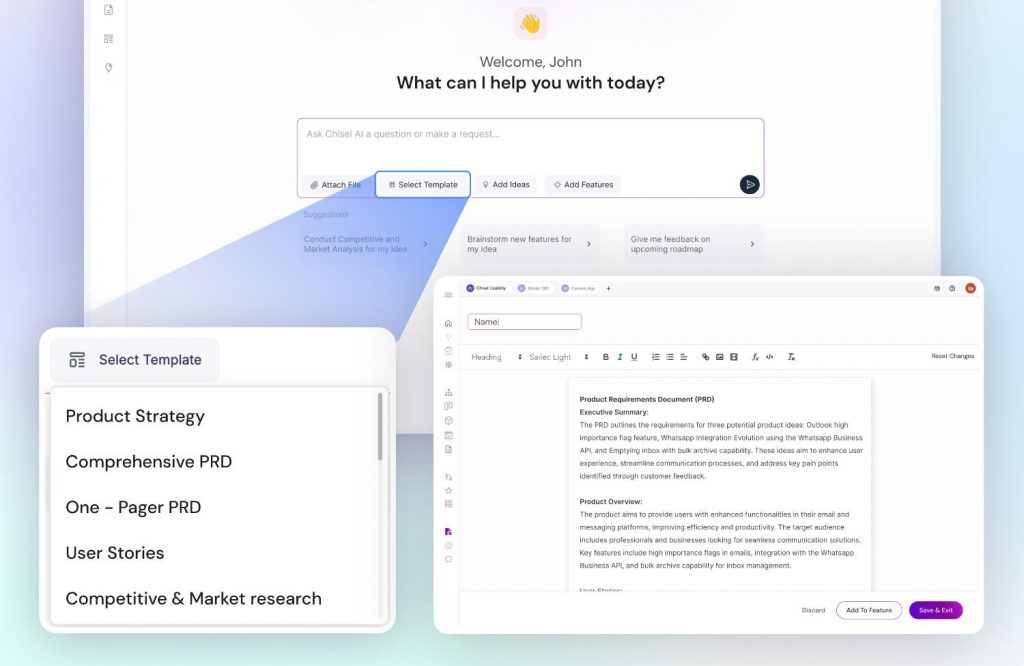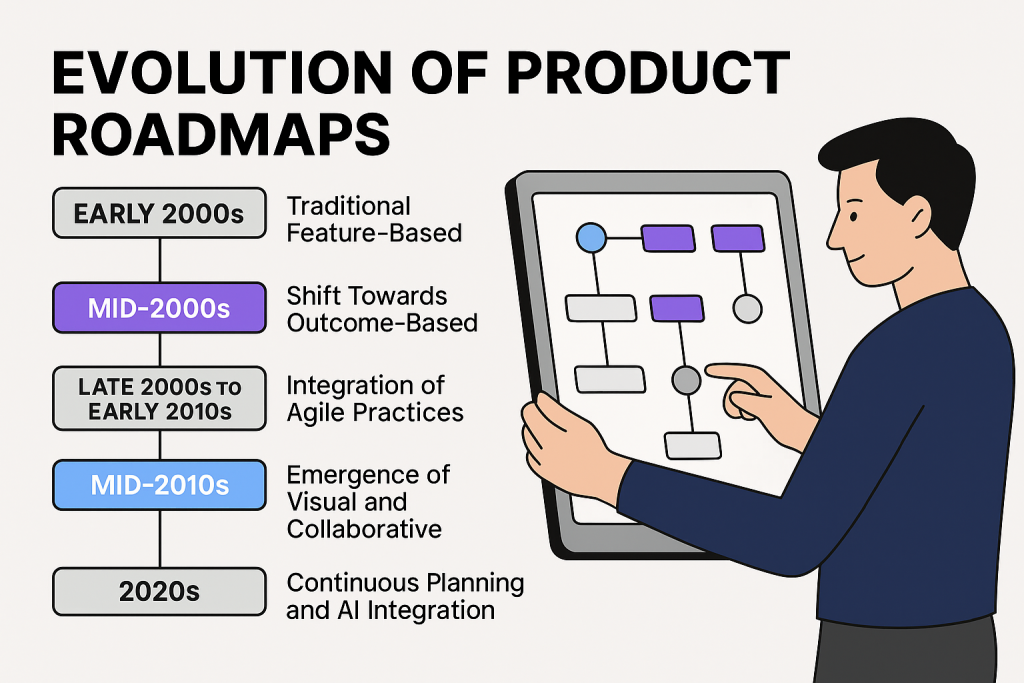Evolution of Product Roadmaps from 2000 to 2025

Let’s Understand:
- Early 2000s: Traditional Feature-Based Roadmaps
- Mid-2000s: Shift Towards Outcome-Based Roadmaps
- Late 2000s to Early 2010s: Integration of Agile Practices
- Mid-2010s: Emergence of Visual and Collaborative Roadmaps
- Late 2010s to Early 2020s: Adoption of Now-Next-Later Frameworks
- 2020s: Embracing Continuous Planning and AI Integration
Product roadmaps function as the GPS for product teams showing where you are going and how to get there, as well as milestones to focus on along the way.
Roadmaps help teams align around goals, prioritize, and communicate with stakeholders. However, roadmaps did not always serve the function they do today.
Roadmaps have transformed from rigid timelines packed with features to flexible frameworks focused on outcomes.
Over the last 25 years, technology and market demands—alongside methodologies like Agile and Lean—have changed the way teams strategically plan, adapt, and deliver value.
In this article, we discuss the evolution of product roadmaps from the early 2000s plans to today’s constantly updated AI-assisted tools.
Early 2000s: Traditional Feature-Based Roadmaps
In the early 2000s, product roadmaps looked quite different from the way they do today.
Most companies followed a feature-based approach which meant that a lot of attention was placed on delivering a specific set of features within a given timeframe.
What Did These Roadmaps Look Like?
Consider a roadmap as a detailed plan (like a Gantt chart) which outlines in great detail what features would be delivered and on what dates.
These useful documents often spanned 12-18 months (or even longer) and everything was planned upfront.
Once these documents were approved, the team would adhere to the roadmap regardless of changing circumstances.
A traditional roadmap would look like this:
Q1: Enable user login feature
Q2: New dashboard goes live
Q3: Add Analytics module
It was all very orderly and predictable—at least in theory.
Why Were They Popular?
For stakeholders, this approach made sense at the time. They had clear insight into what was coming next.
The marketing and sales teams could draft campaigns months in advance, customers had their expectations set, and the leadership felt at ease because most things looked “under control.”
The Big Challenges
But here’s the catch: plans like these do not often succeed in the world of unpredictable reality.
Zero Adaptability
If customer needs grew or competitors initiated offering something different, teams found it extremely difficult to adapt. Everything was already ‘locked in’.
Shipped Outdated
Technology was rapidly evolving. A feature that was set to launch at the beginning of the year would most likely become obsolete by the time it was actually scheduled for launch.
High Chances of Building Something Useless
Without proper validation, most teams would build features assuming customers would want them. Feedback cycles were absent or simply stagnant.
Real Life Example
During this phase, companies like Nokia and Blackberry were rigidly adhering to the strict feature-driven roadmaps.
They prioritized meeting expectations instead of shifting requirements which turned out to be their downfall.
This rigid roadmap approach was a stepping stone towards modern strategies as these had a limited focus on agility, adaptability, and responsive feedback, which is what prepared teams for the future.
Mid-2000s: Shift Towards Outcome-Based Roadmaps
What Triggered the Change?
Product team realizations kicked in the mid-2000s when rigid, feature-centric planning proved to be ineffective.
Detailed feature-laden roadmaps were long-term and dealt with anticipating future customer needs.
However, these plans often failed due to unanticipated shifts in customer needs, market conditions, or fundamental changes in customer expectations.
Businesses started understanding that a comprehensive list of features did not guarantee customer satisfaction or business prosperity.
On parallel tracks, Agile and Lean implementation frameworks were gaining popularity. These frameworks encouraged teams to be more iterative, learn-driven, flexible, and adaptive.
Instead of focusing on “What features do we need to ship?”, teams began asking, “What problems can we solve for our users?”
Rise of Outcome Driven Roadmaps
This is what led to the development of outcome based roadmaps — after all, these frameworks can now be defined as goal-oriented rather than defined by activities performed towards achieving that goal.
Rather than outlining features, these roadmaps concentrated on the impact or results on customers, goals and the impact the activities would have.
For instance, instead of planning to “build a new reporting dashboard,” a team could have objective-based targets such as “increase user onboarding completions by 20%.”
These changes also impacted the ways product managers operated.
Around this time, instead of working through a checklist of tasks, product managers began to focus on aligning product activities with company key objectives.
Example: enhancing customer retention and increasing revenue in target markets.
Real World Example
A good illustration is Atlassian’s published public roadmap screenshot that marked the shift from fixed roadmaps to more flexible ones, which prioritize customer value.
Their public product roadmap does not emphasize delivering features on certain dates, but rather, focuses on solving customer issues.
Why It Mattered
This approach creates a certain degree of adaptability for different teams.
If a feature was not working or some change occurred in the market, teams could pivot without completely scrapping the roadmap.
It enhanced collaboration as well because developers, designers, and even stakeholders began to work towards shared goals—and not merely ticking off features.
Everywhere outcome-based roadmaps emerged, they provided a more flexible, strategic customer-centric way of working, which prepared organizations for advanced product thinking.
Late 2000s to Early 2010s: Integration of Agile Practices
The Rise of Agile Thinking
Agile development was no longer a buzzword by the 2000s, it was becoming a norm for product and engineering teams.
The principles of Agile—iterative steps, continuous feedback, and collaboration among diverse teams—began to affect every product-related activity such as roadmap development and utilization.
As technology advanced, it became clear to teams that long-term, rigid plans were counterintuitive.
The agile methodology provided them with learned adaptability as well as the ability to directly respond to customer feedback.
Roadmaps Became Living Documents
This change impacted how product roadmaps were presented.
Roadmaps transformed from stagnant documents containing timelines and features locked months or years in advance into flexible resources that evolved alongside learned and built changes.
Themes and epics, which denote larger groupings of work, were another addition that transformed static roadmaps into dynamic resources.
Work direction was provided but without every detail set in stone. This permitted teams to align towards broader goals while still retaining room for iteration and discovery.
For instance, instead of “add five new filters to search,” a task might center around “improving search relevance and speed.”
Advantages of Agile-Driven Roadmaps
Several advantages emerged as Agile practices influenced the design of roadmaps:
Improved customer satisfaction: With Agile practices, teams were able to change priorities after every sprint or release cycle.
Reduced time needed to bring product to market: Roadmaps not being encumbered by feature bloat allowed teams to deliver value more rapidly.
Enhanced ownership at the team level: Contributors at every level, including PMs, engineers, and designers, had the opportunity to influence how the roadmap progressed.
Real Life Example
Many companies, including Spotify, adopted this approach early on. The squad, tribe, and guild model enabled self-organizing teams to pursue shared themes and goals.
Other agile inspired companies have adopted this as a flexible roadmap approach supporting autonomous teams.
This was a defining moment in time—roadmaps transformed from simply being plans into vehicles to accelerate learning and adapting in delivering value.
Mid-2010s: Emergence of Visual and Collaborative Roadmaps
Now the product roadmap wasn’t merely a document, it started to become a collective experience.
The Tech Shift
In the middle of 2010’s tools such as Trello, Aha!, Product Plan, and even Jira started changing the way people constructed and perceived roadmaps.
With the introduction of these tools, construction of roadmaps was no longer mundane document work.
It became living collaborative documents that were digital and visualized in real time. Items could be updated, documents could be attached, changes can be tracked, and so much more– all without the need to send countless emails.
Visual Thinking Takes Over
The dominant use of dense spreadsheets alongside 20 page documents came to a halt.
Product teams were able to employ timelines, boards, and even color coded cards that could break down complicated concepts.
With the advent of visual roadmaps, every single employee, whether they were a product manager, designer, engineer, or in sales and marketing, could understand the direction in which the product was heading with minimal effort.
With the new system, color codes designated for priorities, dependency were shown with icons, and teams or product categories could be separated by swimlanes.
Roadmaps evolved from being just a PM’s resource into a common point of reference for the entire team.
Optimized Collaboration is Productive Collaboration
Most of all, these visuals helped propel Marketing to understand the phenomena in engineering.
For instance, marketers understood what engineering is launching next and planned their campaigns accordingly.
Engineering had clarity on what is coming next and why it matters. Stakeholders no longer had to wait for meetings to get the information—they could log in at any time.
The reason everything was dynamic was because plans could change with customer feedback or signals from the markets.
That flexibility lowered the surprises and increased the alignment.
Real Life Example
Chisel and Aha are examples that enable teams to organize roadmaps by goals, releases and even customer feedback.
Another example is Zapier, a fully remote company that utilized visual product planning processes to keep remote teams aligned and heads unified towards common goals.
By the mid-2010s, the product roadmap had transformed from a static document into a dynamic piece of communication.
It evolved into the centerpiece of planning, collaboration, and dialogue.
Late 2010s to Early 2020s: Adoption of Now-Next-Later Frameworks
As competition intensified, technology advanced at an extraordinary pace, and users started expecting more, product teams understood that they needed a better way to plan.
This need is what led to the introduction of the Now-Next-Later (NNL) framework.
Reasons for the Shift
Even the most collaborative and visual traditional roadmaps were based on outdated feature and deadline frameworks.
In scenarios where customer demands could literally change overnight, teams required flexibility without clarity. The NNL model provided the best of both worlds.
How NNL Works
The NNL framework is straightforward:
Now refers to anything and everything the team is currently engaged in, which includes features in active development, improvements underway, and bug fixes.
Next describes activities that are about to commence, which include validated initiatives that are close to being prioritized.
Later refers to more distant strategic bets, ideas, or problems that require further exploration, but are not bound by time.
This model prioritizes flexibility by eliminating strict timelines attached to every item.
Strategic Advantages
A notable advantage of the NNL framework is its flexibility while still providing a clear structure.
Stakeholders are still provided with a strong sense of direction without needing product managers to issue promises for exact release dates.
It decreases stress on the teams as well.
Developers have the attention right now because they do not have to deal with features scheduled for months in advance.” ideas in the “Later” bucket can still be seen and will be opened when needed, and can be discussed freely.
Practical Example
Monzo and Intercom are other companies that I’ve worked with that apply this NNL model to maintain focus and clarity within their teams.
Some tools like ProdPad go as far as offering features like Now-Next-Later Roadmap structure, N-LLR templates.
This model is especially persuasive for the teams that desire more flexibility while still maintaining the structure to stay organized because there is a constant need for change.
2020s: Embracing Continuous Planning and AI Integration
A significant transformation has been introduced in the 2020s evolving product roadmaps.
Now, modern product teams revolve their work around continuous planning processes. This means that product managers no longer just prepare a plan, they revise and modify the roadmap on a regular basis based on real-time data, market feedback, and other situational factors.
The mindset says; “don’t just stay ahead, be ready too.”
What Is Continuous Planning?
Consider continuous planning to be a roadmap on a treadmill: it is always moving and adjusting.
For example, if there is a sudden change in user behavior or the landscape shifts with a new competitor, the team can pivot when practicing this approach.
This allows product managers the ability to act on changing factors instead of reacting after changes occur.
AI and Automation Step In
Artificial Intelligence has been a boon for this tactic.
Product managers that operate within specific industries are starting to use AI responsively to identify the ever-changing trends in customer behaviors, predict demands, and assess the effectiveness of the product in question—all simultaneously.
This helps lessen the burden of guesswork by enabling teams to confidently adjust plans.
AI also assists with menial tasks. Responsibilities such as information retrieval, arranging appointments, or gathering feedback can now be performed using automation tools.
This allows PMs to devote their attention to higher-level strategy and imaginative work.
The Impact: Improving Decisional Quality and Speed
The combination of advanced planning together with AI is remarkably effective. Companies can anticipate what users next might need, prevent problems from escalating, and better align with company objectives.
Aha!, airfocus, and Productboard offer AI-assisted planning options and these features make it easy to integrate these approaches.
This decade highlights the importance of being responsive, conscious, and flexible.
Roadmaps are no longer simply strategies; they are dynamic instruments that continuously change. With AI in the picture, designing what is to come becomes much easier.
Chisel AI Powered Product Management Software

Over time, Chisel has evolved from a powerful roadmap tool into a comprehensive, AI-powered product management platform that addresses the full spectrum of a PM’s responsibilities. By combining product roadmapping with robust customer feedback capabilities, Chisel has moved beyond basic feature tracking to become a strategic operating system for product teams. The platform’s continual enhancement with cutting-edge AI, like automated PRD and report generation, intelligent feedback classification, and real-time focus alerts, demonstrates its commitment to reducing PM busywork while increasing strategic impact.
Chisel’s evolution is rooted in deep product leadership experience and customer obsession. What began as a solution to help PMs prioritize has grown into an intelligent partner that aligns customer needs with product direction in real time. With world-class usability, seamless integrations, and industry-leading innovation, Chisel continues to set the standard for what modern product management should look like, outcome-driven, customer-connected, and AI-enhanced.
Conclusion

Product roadmaps have evolved from rigid documents bursting with features and deadlines to living tools which support constant collaboration and change.
Early in the 2000s, roadmaps were highly feature oriented and bound by time constraints.
Businesses had product plans outlined for months and even years ahead, often putting themselves in positions where change of customer demand or market shifts cannot be accommodated.
With the adoption of Agile and Lean practices in the mid-2000s, roadmaps started shifting more towards outcomes and having flexible framework.
In the late 2000s and early 2010s, Agile brought integration with thematic planning and added quicker iteration cycles.
Collaborative visual roadmaps started to emerge in the mid 2010s which enhanced alignment and transparency across teams and provided clear visibility to the required direction.
The 2020s welcomed the Now-Next-Later brackets, continuous planning, and AI enabled roadmapping which allowed data, automation, and flexible frameworks to be in focus.
The evolving methodology of planning during the years demonstrates one major shift. In comparison to the previous years static map style planning, roadmaps now aim to maintain flexibility and customer emphasis during execution.
The static roadmaps can now be seen as dynamic compasses guiding teams through navigation of ever changing territory.
As we try to anticipate what the future will bring, evolving flexible mapping will surely be dictated need to focus on the right goals that require attention. In other words, avoid being afraid of change and ensure flexibility without losing curiosity and allow iterating to be the drive.
